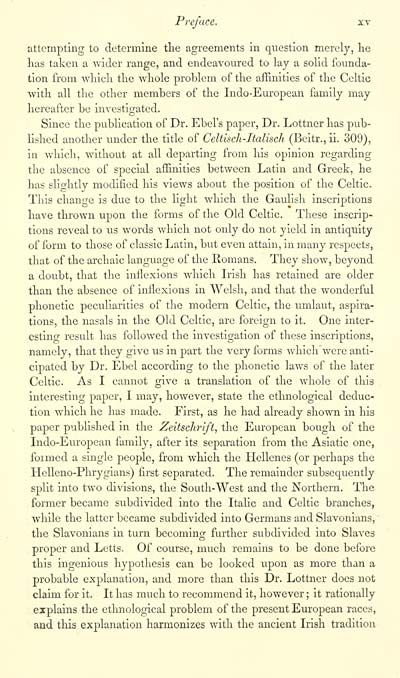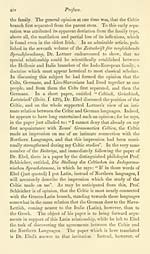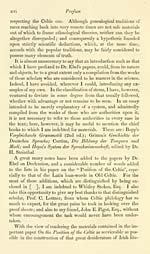Blair Collection > Celtic studies
(19)
Download files
Complete book:
Individual page:
Thumbnail gallery: Grid view | List view

Preface. xv
attempting to determine tlie agreements in question merely, he
lias taken a wider range, and endeavoured to lay a solid founda-
tion from which the whole problem of the affinities of the Celtic
with all the other members of the Indo-European family may
hereafter be investigated.
Since the publication of Dr. Ebel's paper, Dr. Lottner has pub-
lished another under the title of Celtisch-Italisch (Bcitr., ii. 309),
in which, without at all departing from his opinion regarding
the absence of special affinities between Latin and Greek, he
has slightly modified his views about the position of the Celtic.
This change is due to the light which the Gaulish inscriptions
have thrown upon the forms of the Old Celtic. These inscrip-
tions reveal to us words which not only do not yield in antiquity
of form to those of classic Latin, but even attain, in many respects,
that of the archaic language of the Romans. They show, beyond
a doubt, that the inflexions which Irish has retained are older
than the absence of inflexions in Welsh, and that the wonderful
phonetic peculiarities of the modern Celtic, the umlaut, aspira-
tions, the nasals in the Old Celtic, are foreign to it. One inter-
esting resvilt has followed the investigation of these inscriptions,
namely, that they give us in part the very forms which were anti-
cipated by Dr. Ebel according to the phonetic laws of the later
Celtic. As I cannot give a translation of the whole of this
interesting paper, I may, however, state the ethnological deduc-
tion which he has made. First, as he had already shown in his
paper published in the Zeitschrift, the European bough of the
Indo-European family, after its separation from the Asiatic one,
foimed a single people, from which the Hellenes (or perhaps the
Helleno-Phrygians) first separated. The remainder subsequently
split into two divisions, the South-West and the Northern. The
former became subdivided into the ItaHc and Celtic branches,
while the latter became subdivided into Germans and Slavonians,
the Slavonians in turn becoming further subdivided into Slaves
proper and Letts. Of course, much remains to be done before
this ingenious hypothesis can be looked upon as more than a
probable explanation, and more than this Dr. Lottner does not
claim for it. It has much to recommend it, however ; it rationally
explains the ethnological problem of the present European races,
and this explanation harmonizes with the ancient Irish tradition
attempting to determine tlie agreements in question merely, he
lias taken a wider range, and endeavoured to lay a solid founda-
tion from which the whole problem of the affinities of the Celtic
with all the other members of the Indo-European family may
hereafter be investigated.
Since the publication of Dr. Ebel's paper, Dr. Lottner has pub-
lished another under the title of Celtisch-Italisch (Bcitr., ii. 309),
in which, without at all departing from his opinion regarding
the absence of special affinities between Latin and Greek, he
has slightly modified his views about the position of the Celtic.
This change is due to the light which the Gaulish inscriptions
have thrown upon the forms of the Old Celtic. These inscrip-
tions reveal to us words which not only do not yield in antiquity
of form to those of classic Latin, but even attain, in many respects,
that of the archaic language of the Romans. They show, beyond
a doubt, that the inflexions which Irish has retained are older
than the absence of inflexions in Welsh, and that the wonderful
phonetic peculiarities of the modern Celtic, the umlaut, aspira-
tions, the nasals in the Old Celtic, are foreign to it. One inter-
esting resvilt has followed the investigation of these inscriptions,
namely, that they give us in part the very forms which were anti-
cipated by Dr. Ebel according to the phonetic laws of the later
Celtic. As I cannot give a translation of the whole of this
interesting paper, I may, however, state the ethnological deduc-
tion which he has made. First, as he had already shown in his
paper published in the Zeitschrift, the European bough of the
Indo-European family, after its separation from the Asiatic one,
foimed a single people, from which the Hellenes (or perhaps the
Helleno-Phrygians) first separated. The remainder subsequently
split into two divisions, the South-West and the Northern. The
former became subdivided into the ItaHc and Celtic branches,
while the latter became subdivided into Germans and Slavonians,
the Slavonians in turn becoming further subdivided into Slaves
proper and Letts. Of course, much remains to be done before
this ingenious hypothesis can be looked upon as more than a
probable explanation, and more than this Dr. Lottner does not
claim for it. It has much to recommend it, however ; it rationally
explains the ethnological problem of the present European races,
and this explanation harmonizes with the ancient Irish tradition
Set display mode to: Large image | Transcription
Images and transcriptions on this page, including medium image downloads, may be used under the Creative Commons Attribution 4.0 International Licence unless otherwise stated. ![]()
| Early Gaelic Book Collections > Blair Collection > Celtic studies > (19) |
|---|
| Permanent URL | https://digital.nls.uk/75771391 |
|---|
| Description | A selection of books from a collection of more than 500 titles, mostly on religious and literary topics. Also includes some material dealing with other Celtic languages and societies. Collection created towards the end of the 19th century by Lady Evelyn Stewart Murray. |
|---|
| Description | Selected items from five 'Special and Named Printed Collections'. Includes books in Gaelic and other Celtic languages, works about the Gaels, their languages, literature, culture and history. |
|---|

